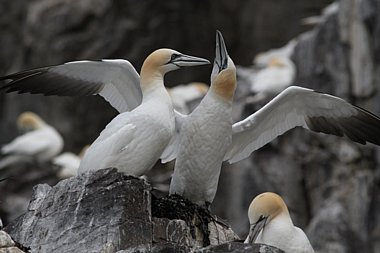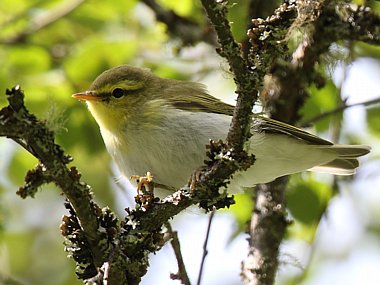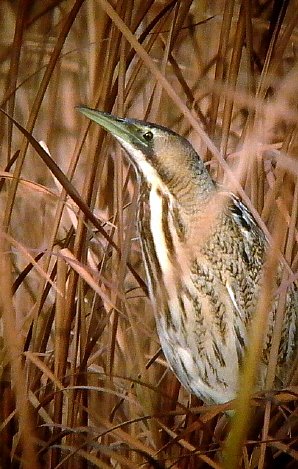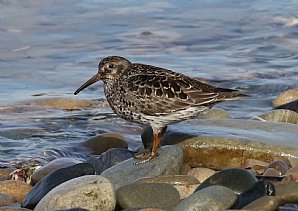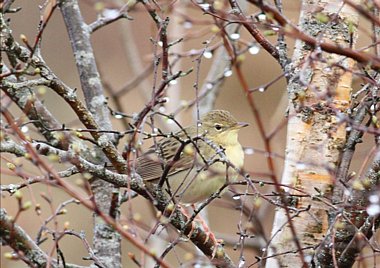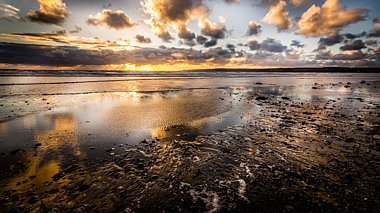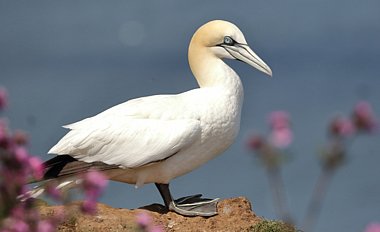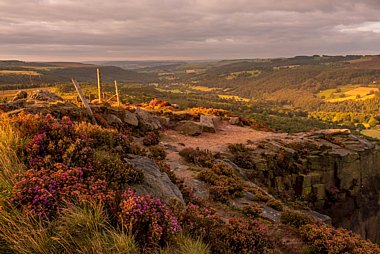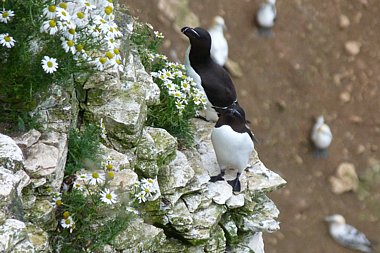Peak District, Yorkshire Coast & Norfolk in Spring
| Destination | |
|---|---|
| Focus | |
| 2026 Dates | |
| Duration | 8 Days |
| 2026 Price | £2245 pp £230 single supplement. Deposit £300 |
| Max Group Size | 12 |
This exciting new two-centre holiday is designed to cover a broad cross-section of upland and lowland bird species including spring migrants and breeding birds, from several different habitats including moorland, woodland, heathland, wetland and coast. It is especially useful as an introduction to birding for beginners, or for those seeking speciality species.
We begin in South Yorkshire in the Dark Peak region of the Peak District, an area typified by extensive open areas of upland heather moorland, with steep-sided ‘cloughs’ or small valleys incised into the hills, often containing relict oak and birch woodland. Below the moorland edge, coniferous plantations, broad-leaved woodlands and water-supply reservoirs with fast flowing streams in the valleys add to the upland landscape and scenery. We visit a range of sites and look for key species which breed in this upland area, including Red Grouse, Golden Plover, Short-eared Owl, Merlin, Whinchat and Ring Ouzel on the moorland, Pied and Spotted Flycatcher, Redstart, Wood Warbler and Crossbill in the woodland and adjacent habitats, Little Ringed Plover and Common Sandpiper on the reservoir margins and we venture out for an evening visit to the moorland edge for Nightjar and Woodcock.
From our base in the Peak District, we take a day trip to the Yorkshire coast and the breeding seabird colonies at RSPB Bempton Cliffs, where we will see a range of species including Puffin, Gannet, Kittiwake, Razorbill, Guillemot, Fulmar and Shag, most at close range from the cliff tops. We also have a leisurely walk around the nearby headland at Flamborough seeking migrants in the hedgerows and scrub and look out for Corn Bunting and Red Kite whilst driving across the Yorkshire Wolds on our journey to and from the coast.
For the next part of the tour we travel south-east to Norfolk and our second base near King’s Lynn in West Norfolk. On the way we break our journey in south Lincolnshire to visit Frampton Marsh RSPB on the western margin of The Wash, one of the broadest estuaries in the UK. Here we spend time looking for migrant waders which may include Curlew Sandpiper, Little Stint or perhaps a rarity, plus other migrants such as Little Gull and Black Tern, and late winter visitors such as Brent Goose. Our hotel is well positioned for access to birding sites in Breckland where we look for Stone Curlew and Woodlark, in particular at Weeting Heath NWT, and a range of birds in the wetland fen habitat at RSPB Lakenheath reserve, including Crane, Bittern, Garganey, Bearded Tit, Cetti’s Warbler and several species of summer migrant warbler. We are also well placed for visiting Titchwell RSPB and Cley Marshes NWT, two of Britain’s premier birding sites on the North Norfolk coast. Our day birding on the Norfolk coast should give us many potential highlights, such as Dartford Warbler and Woodlark on the coastal heathland and a wide range of wetland and marshland birds including Bittern, Spoonbill, several wildfowl and wader species, gulls, terns, raptors and passerines.
A rewarding tour of the breeding birdlife of eastern and northern England!
Day 1: Sun 2 June 2024 - arrival and local birding in the Dark Peak
We meet at Sheffield Midland railway station around 2pm, before heading to our accommodation. After time to settle in and freshen up, our birding begins at the River Don to look for Dipper and woodland birds such as Green Woodpecker, Blackcap, Nuthatch and Treecreeper, whilst also considering any scarce migrants which may be present locally.
Day 2: Mon 3 June - Dark Peak moorlands
Today we focus on upland birds of the open heather moorlands, fields of rush pasture, woodland edge and reservoirs of the Dark Peak region. Red Grouse are resident on the heather moorland, with breeding waders on the moors including Golden Plover and Curlew, Snipe and Lapwing in the fields and rush habitat plus Dunlin on the remote high elevation moorland blanket bog. Raptors such as Merlin, Hobby and Peregrine are likely, Buzzard and Raven pass overhead and Short-eared Owl is also possible. Ring Ouzel breed in some of the local ‘cloughs’ (small valleys incised into the moorland), with Cuckoo, Wheatear, Whinchat, Meadow Pipit and Skylark nearby and Reed Bunting in wetter areas. Woodland edge, and areas of clear-fell becoming colonised by young trees are important habitats for Tree Pipit and Willow Warbler, whilst Redstart and Pied Flycatcher can be seen in the woodland and Common Sandpiper, Little Ringed Plover and Oystercatcher along the rocky margins of local upland reservoirs.
Watching the weather forecast, on one of our evenings based in the Peak District we may offer an optional evening visit to a site along the moorland edge for Nightjar and ‘roding’ Woodcock.
Day 3: Tue 4 June - RSPB Bempton Cliffs, Yorkshire coast and wolds
This morning we head to the Yorkshire coast and a complete change of scenery. A visit to the spectacular cliffs at RSPB Bempton is a must, taking in the large and noisy colonies of nesting seabirds. From the clifftop watch-points, we will encounter Kittiwake, Guillemot, Razorbill, Puffin, Gannet, Fulmar and Shag, whilst offshore we may see passage Arctic Skua and Sandwich Tern. Peregrine is also likely here, with Rock Pipit, Stonechat and migrants too. At nearby Flamborough headland, a walk around the fields and hedgerows may reveal late-migrants such as Spotted Flycatcher Black Redstart, or perhaps something even rarer like a Red-backed Shrike, Icterine Warbler or Bluethroat if the weather conditions are suitable. Our route to and from the coast takes us through the rolling farmland of the Yorkshire Wolds, where we look out for Red Kite and Corn Bunting or a daylight hunting Barn Owl.
Day 4: Wed 5 June - Dark Peak Woodlands
Returning to the uplands, we concentrate on woodland birds in the Dark Peak region of the Peak District. We drive south birding en route, over the moorlands and through wooded upland valleys and small villages to Padley Gorge, a deep and narrow well-wooded valley which supports some key woodland species. Following the footpath on a leisurely walk through the valley, we look for Wood Warbler, Redstart, Spotted and Pied Flycatcher, Nuthatch and possibly Willow Tit, plus Dipper and Grey Wagtail on Burbage Brook which runs through the valley to meet the River Derwent further south. We travel back north to visit the well-wooded Ewden Valley, trails close to Broomhead Reservoir give us another opportunity for any woodland birds not yet have seen and also Lesser Redpoll, Crossbill and Garden Warbler. Some time looking for raptors from a watch-point above the valley could yield Hobby and Red Kite, and where migrant Honey Buzzard has occasionally been seen.
Day 5: Thurs 6 June - Norfolk via RSPB Frampton Marsh
Today we change habitats again, transferring from the uplands of the Peak District to the lowlands of Norfolk, calling en-route at RSPB Frampton Marsh on the eastern shore of the Wash in south Lincolnshire to look for passage waders and wetland birds. Always a bird filled reserve, among the commoner wader species we might encounter Curlew Sandpiper, Little Stint, Grey Plover, Whimbrel, Greenshank, Turnstone, Black-tailed Godwit, Sanderling and Knot and if lucky perhaps something rarer. There may be some late lingering Brent Geese on the saltmarsh or migrant Black Tern and Little Gull moving through. Marsh Harrier are likely and we keep an eye open for Montagu’s Harrier, an irregular passage migrant on the east coast. Moving on we continue to our Norfolk hotel where we are well placed for birding Breckland and the North Norfolk coast.
Day 6: Fri 7 June - Norfolk and Breckland
Roydon Common NWT reserve is a heathland site rich in birds and wildlife, and being close to our accommodation a pre-breakfast visit here for Woodlark and Grasshopper Warbler will be a good start. After breakfast we drive south into Breckland where one of our first targets will be Stone Curlew. While looking out over the heath for this cryptic bird, we keep our eyes and ears open for Woodlark, which may be singing overhead or from the pine trees. Marsh Harrier and Little Owl are also likely here, with Tree Pipit, Common Crossbill, Green Woodpecker and Spotted Flycatcher all possible in the woods and woodland edge.
Next we drive the short distance to RSPB Lakenheath Fen, on the Norfolk/Suffolk border where a leisurely walk along the trails will provide us with a good selection of wetland birds in rich fenland habitat. Common Crane is a key target here, and with a small number of birds becoming established we hope to connect with this stately bird. We look out for Bittern, Bearded Tit, Kingfisher and elusive, but vocal Cetti’s Warbler, and also see Reed, Sedge and Garden Warbler in the reedbed and scrub habitat. Hobby is likely overhead as is Marsh Harrier over the reedbeds, and on the wetland areas Great Crested Grebe, Shoveler, Common Tern and perhaps Garganey may feature.
After dinner, we have another good option (depending on our success earlier in the week) for Nightjar and Woodcock during an evening visit to a nearby site.
Day 7: Sat 8 June - North Norfolk coast
After an early breakfast, we head up to the North Norfolk coast for a busy final day. First, we check heathland habitat inland from the coast for Dartford Warbler, Woodlark and Tree Pipit before moving on to nearby Cley Marshes NWT - one of the most famous birding sites in Britain. Here we walk to the hides to view the pools and scrapes for wetland birds, including Spoonbill, Bittern, Egyptian Goose, an array of wildfowl and waders with the chance of a rarity also possible. A walk out to the East Bank and across the reserve to the shingle bank and sea, checking Pope’s Marsh and Arnold’s Marsh can be productive for waders and terns with warblers and Bearded Tit in the reedbeds. Later, we visit RSPB Titchwell where a walk to the coast birding the saltmarsh, reedbeds and freshwater lagoons will reveal an interesting selection of birds including wildfowl, waders, gulls, terns, raptors and passerines. On the reserve we look for Garganey, Red-crested Pochard, Brent Goose, waders including Avocet, Wood Sandpiper, Black-tailed Godwit, Greenshank and perhaps a rare Temminck’s Stint, while scanning from the beach may reveal Common Scoter and Little Tern moving past.
Day 8: Sun 9 June - Departure
The tour concludes after breakfast and clients can be dropped at King’s Lynn railway station for onward travel home, or travel back with us to Sheffield station to meet connecting trains there.
Please note: all itineraries are given as a guide only. Actual holiday content may vary according to the judgement of your guide, and elements beyond our control (eg weather).
What's included in your holiday price
- Seven nights comfortable en-suite hotel accommodation. We choose from our personally inspected shortlist, where birders are welcome and the hospitality is special. Guests are never expected to share. All rooms are en-suite. Full details with your joining pack.
- Full English breakfast and dinner from Sunday evening till Sunday morning, packed lunch each day from Monday to Saturday.
- All entrance fees for reserves
- All transport by comfortable minibus.
- Guidance from a professional Group Leader.
What's not included in your holiday price
- Insurance, drinks and other items of a personal nature.
Guide
Dave Pearce
Originally from Barnsley, Dave now lives in East Yorkshire, and alongside guiding for Heatherlea works as a Consultant Ornithologist, undertaking bird surveys, bird monitoring and research from Scotland to Kent, Wales to Norfolk and many points in-between.
Field Notes
Expect a wide variation in weather conditions, which can be wild and unpredictable, with temperatures perhaps averaging around 16°C. Sunshine, rain and strong winds are all possible, and you will probably experience a bit of everything. Biting insects are not expected. Please bring waterproof walking boots or shoes, weatherproof clothing and a small rucksack. Exposed coastal locations can be cold at any time of year if the wind picks up, please pack accordingly. The holiday will be run at a relaxed pace, with time for photography, general wildlife and botany as well as fabulous birdwatching in a spectacular setting! There will be short to moderate (1 to 3 mile) walks most days mainly on well walked tracks and paths, nothing over strenuous, but a reasonable level of health would be an advantage to be able to get off the beaten track and away from vehicular access.
Other birding and wildlife holidays in Northern England
Why choose Heatherlea for your birding and wildlife holiday?
Heatherlea is one of Britain's leading wildlife holiday operators. In 2019 we celebrate our 29th Anniversary with more choice than ever, both in Scotland and overseas. Relax and enjoy yourself, as we do all the planning! Above all, we make it our business to show key wildlife to you. Our fully inclusive guided holidays concentrate on the real experience, and we take time to ensure that each of our guests enjoys everything we do.
- We have been organising birding and wildlife holidays for 30 seasons, and have a highly experienced and capable office team. We also offer a telephone and email service outside normal office hours.
- We are a small company, run BY birders FOR birders. Come and see!
- Heatherlea are Mainland Scotland’s FIRST ‘5-Star Wildlife Experience!’ This is the highest available grading, classified as ‘exceptional’ by visitScotland.
- Heatherlea hold full Tour Operator Insurance for your added protection.
- Heatherlea is a limited company, registered in Scotland. We are also registered to pay VAT, which is included in your holiday price as quoted on this page.
- Once your holiday is confirmed in writing by us, we promise not to surcharge the price for any reason.



